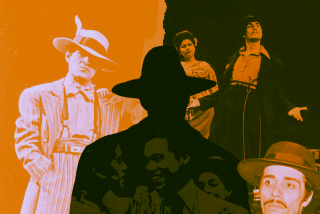The Peruvian Paso: Horse With a Flair
- Share via
LIMA, Peru — Descendants of the mighty horses that carried gold-starved Spaniards to New World conquests still amble proudly, though strangely, through Peru.
The Peruvian paso horse, with its rare walking gait, offers a more comfortable ride than the trotter so popular in the United States.
“It has the smoothest ride in the equine kingdom,” says Vern Albright, a Californian and founder of the American Assn. of Owners and Breeders of Peruvian Paso Horses.
Unorthodox Stride
Its reputation is nourished by an unorthodox stride--a flared step that makes it appear to be walking on broken forelegs.
The paso flicks its front hoofs outward and upward to finish each step in a motion known as termino. The walking gait makes for rider comfort because the horse’s back barely moves.
The handsome, well-proportioned animal with its aristocratic bearing was the favored mount of Peru’s powerful landed gentry, and it still plays a major role in the folk traditions to which most Peruvians cling.
Fairs, bullfights and important fiestas often feature the long-maned pasos , in traditional gear and carrying horsemen in the wide-brimmed straw hats and flowing ponchos of 18th-Century caballeros.
Peru’s economic woes and leftist guerrilla insurgencies have not impeded the nation’s wealthy from promenading their prized pasos at horse shows here and abroad.
Foreign Sales Decline
But Peruvian breeders say the growing violence and shrinking economy have deterred Americans from coming to Peru to buy, and foreign sales have declined during this decade.
History has obscured exactly how the paso developed its marked walking style.
A frequent explanation is that the animal began flaring its front hoofs during centuries of tramping Peru’s 1,500-mile desert coastline, seeking to shake the sand with each step.
But longtime Peruvian breeder Jose Otero says the gait is a legacy of European and Arab horses, which interbred during the Middle Ages domination of Spain by the Moors.
Descended From War Horses
The Peruvian paso descends directly from 75 Spanish war horses used by conquistador Francisco Pizarro and his men in the conquest of the rich Incan empire in the early 1500s, the Peruvian Paso Horse Assn. says.
“Selective breeding plus such factors as climate and diet served to modify succeeding generations and create a new breed,” says Albright, who once rode his paso from Peru to California to demonstrate its fabled endurance.
The Peruvian association says a similar horse exists in Central America, but its bloodline has been corrupted by interbreeding. The Peruvian paso , it says, has remained pure for more than 450 years because of this Andean nation’s isolation and its firmly held traditions.
Walking Gait Preferred
While the United States and most South American nations needed trotters to drive cattle, Peruvians used the walking-gaited paso for traveling and for work on huge cotton and sugar-cane haciendas.
Today, the paso is used mainly in Peru and the United States as a show horse, although Otero says it is still relied on for transportation in some of Peru’s isolated regions.
He estimates that there are nearly 5,000 purebred pasos in Peru, more than 4,000 in the United States and about 2,000 in other Latin American and European countries.
Most pasos in the United States sell for between $8,000 and $50,000, but top-quality mounts go for as much as $200,000. Otero says pasos of equal caliber in Peru cost one-fifth as much.
More to Read
Sign up for Essential California
The most important California stories and recommendations in your inbox every morning.
You may occasionally receive promotional content from the Los Angeles Times.











